Globalisation, the now quaint buzzword of the noughties, was actually first conceptualised in the 1800s when steam power and imperialism made international trade a reality. Today’s wealthy nations rest on the pillars built by the aggressive successes of the past, which have sense evolved from what trade policy expert Richard Baldwin calls the Great Divergence.
The new globalisation is driven by new technologies in a world where knowledge, rather than capital alone, is power. While globalisation 1.0 relied on technology to lower costs and increase the speed of moving goods across borders, new globalisation uses technology to do the same for the movement of ideas across borders. From this grew off-shoring, crowdsourcing, and other HR jargon of the modern corporate world, where multinational companies can shift labour-intensive work to a skilled workforce in developing nations with lower costs of living. Everybody wins, right?
Baldwin’s book, The Great Convergence – Information Technology and the New Globalization, examines the pros and cons of off-shoring business functions and the new possibilities for growth for the collective workforce. Here are his top six predictions for this new wave.
It will affect national economies with a finer degree of resolution
The new globalisation’s impact is also more individual in the sense that the winners and losers are no longer mostly grouped by sectors and skill groups. Globalisation’s impact can vary across workers who possess the same skill sets and work in the same sectors.
It will have a more sudden and more uncontrollable impact
The passage of time on the Old Globalisation “clock” was marked in years, since that is how long it took for tariff cuts and transportation improvements to take effect. The New Globalisation, by contrast, is more sudden due to the fact that it is driven by the doubling of transmission, storage, and computing capacity every year or two.
It will denationalise comparative advantage
G7 firms are leveraging their firm-specific know-how by combining it with labor in low-wage nations. With firms mixing and matching different nations’ sources of competitiveness, nations are no longer the only natural unit of analysis. Increasingly, the boundaries of competitiveness are controlled by firms who run international production networks.
It will rupture the compact between G7 workers and G7 firms
When technology was national, international wage gaps adjusted to international technology differences. The New Globalisation means that British workers are no longer the only beneficiaries of British technological advances. British firms can now exploit improved British technology by combining it with, say, Polish labour. Similar things could be said about firms and workers in all the G7 nations.
It will change the role of distance
Standard thinking characterises globalisation as being mostly about goods crossing borders. Applying this logic today is a mis-thinking of twenty-first-century globalisation for a very simple reason. Cartographical distances affect the cost of moving goods, ideas, and people in very different ways. With the Internet, the cost of moving ideas is almost zero and varies little with distance.
It will change how governments think about their policies
Vast swaths of economic policy are based on the notion that competitiveness is a national feature. Globally competitive firms knit together national competitive advantages to make things in the most cost- effective locations. Firms and nations that eschew this new school of mix-and-match competitive advantage struggle to compete with those that have embraced it.






